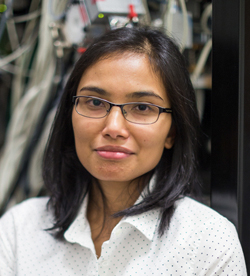Isabelle Baconguis, Ph.D.

Assistant Scientist, Vollum Institute
Email: bacongui@ohsu.edu
Phone: 503-494-5899
Office: Vollum 1427A
Biography
Isabelle Baconguis graduated from the University of Pennsylvania with a B.A. in Biochemistry in 2005. She remained at the University of Pennsylvania for two years studying glutamate receptors. She joined the Neuroscience Graduate Program at OHSU in 2007. During her doctoral research at the Vollum Institute, she studied acid sensing ion channels (ASICs), members of the superfamily of amiloride-sensitive and Na+-selective trimeric ion channels. Using a combination of x-ray crystallography and electrophysiology, she exploited toxin-dependent modulation of ASIC function to elaborate molecular mechanisms of gating, selectivity and ion channel block. She joined the Vollum Insitute as a Vollum fellow in 2013 and was promoted to assistant scientist in 2016.
Summary of current research
The Baconguis lab is pursuing atomic-resolution mechanisms of Na+-selective and voltage-independent ion channels involved in a spectrum of processes ranging from synaptic transmission to regulation of salt homeostasis. We are especially interested in how detection of different stimuli, such as the binding of ligands or region-specific proteolysis, is coupled to the opening of a Na+-selective transmembrane pore. The current focus of the lab is to develop molecular mechanisms of heteromeric channel assembly, channel gating and ion selectivity. The lab further seeks to map the binding sites of modulators with the long-term goal of providing blueprints for rational design of novel therapeutic agents for the treatment of diseases that include hypertension and cystic fibrosis. We employ diverse yet complementary biophysical and biochemical approaches with an emphasis on x-ray crystallography, cryo-electron microscopy (cryo-EM), and electrophysiology.
Selected publications
Houser A, Baconguis I. (2025) Structural insights into subunit-dependent functional regulation in epithelial sodium channels. Structure. doi: 10.1016/j.str.2024.11.013. Epub 2024 Dec 11. PMID: 39667931.
Cahill J, Hartfield KA, Heusser SA, Poulsen MH, Yoshioka C, Pless SA, Baconguis I. (2024) Conformational plasticity of human acid-sensing ion channel 1a. bioRxiv [Preprint]. doi: 10.1101/2024.12.11.628012. PMID: 39713315 Free PMC article. Preprint.
Posert R, Baconguis I. (2023) Appia: Simpler chromatography analysis and visualization. PLoS One. doi: 10.1371/journal.pone.0280255. eCollection 2023. PMID: 36649224 Free PMC article.
Massengill CI, Bayless-Edwards L, Ceballos CC, Cebul ER, Cahill J, Bharadwaj A, Wilson E, Qin M, Whorton MR, Baconguis I, Ye B, Mao T, Zhong H. (2022) Sensitive genetically encoded sensors for population and subcellular imaging of cAMP in vivo. Nat Methods. doi: 10.1038/s41592-022-01646-5. Epub 2022 Oct 27. PMID: 36303019.
Yoder N, Jalali-Yazdi F, Noreng S, Houser A, Baconguis I, Gouaux E. (2020) Light-coupled cryo-plunger for time-resolved cryo-EM. J Struct Biol. doi: 10.1016/j.jsb.2020.107624. Epub 2020 Sep 17. PMID: 32950604 Free PMC article.
Noreng S, Posert R, Bharadwaj A, Houser A, Baconguis I. (2020) Molecular principles of assembly, activation, and inhibition in epithelial sodium channel. Elife. doi: 10.7554/eLife.59038. PMID: 32729833 Free PMC article.
Noreng S, Bharadwaj A, Posert R, Yoshioka C, Baconguis I. (2018) Structure of the human epithelial sodium channel by cryo-electron microscopy. Elife. doi: 10.7554/eLife.39340. PMID: 30251954 Free PMC article.
Zhao Y, Chen S, Yoshioka C, Baconguis I, Gouaux E. Architecture of fully occupied GluA2 AMPA receptor-TARP complex elucidated by cryo-EM. (2016) Nature. doi: 10.1038/nature18961. Epub 2016 Jul 1. PMID: 27368053 Free PMC article.
Goehring A, Lee CH, Wang KH, Michel JC, Claxton DP, Baconguis I, Althoff T, Fischer S, Garcia KC, Gouaux E. (2014) Screening and large-scale expression of membrane proteins in mammalian cells for structural studies. Nat Protoc. doi: 10.1038/nprot.2014.173. Epub 2014 Oct 9. PMID: 25299155 Free PMC article.
Baconguis I, Bohlen CJ, Goehring A, Julius D, Gouaux E. (2014) X-ray structure of acid-sensing ion channel 1-snake toxin complex reveals open state of a Na(+)-selective channel. Cell. doi: 10.1016/j.cell.2014.01.011. Epub 2014 Feb 6. PMID: 24507937 Free PMC article.
Baconguis I, Hattori M, Gouaux E. (2013) Unanticipated parallels in architecture and mechanism between ATP-gated P2X receptors and acid sensing ion channels. Curr Opin Struct Biol. 2013 doi: 10.1016/j.sbi.2013.04.005. Epub 2013 Apr 26. PMID: 23628284 Free PMC article. Review.
Baconguis I, Gouaux E. Structural plasticity and dynamic selectivity of acid-sensing ion channel-spider toxin complexes. Nature. 2012 Sep 20;489(7416):400-5. doi: 10.1038/nature11375. Epub 2012 Jul 29. PMID: 22842900.